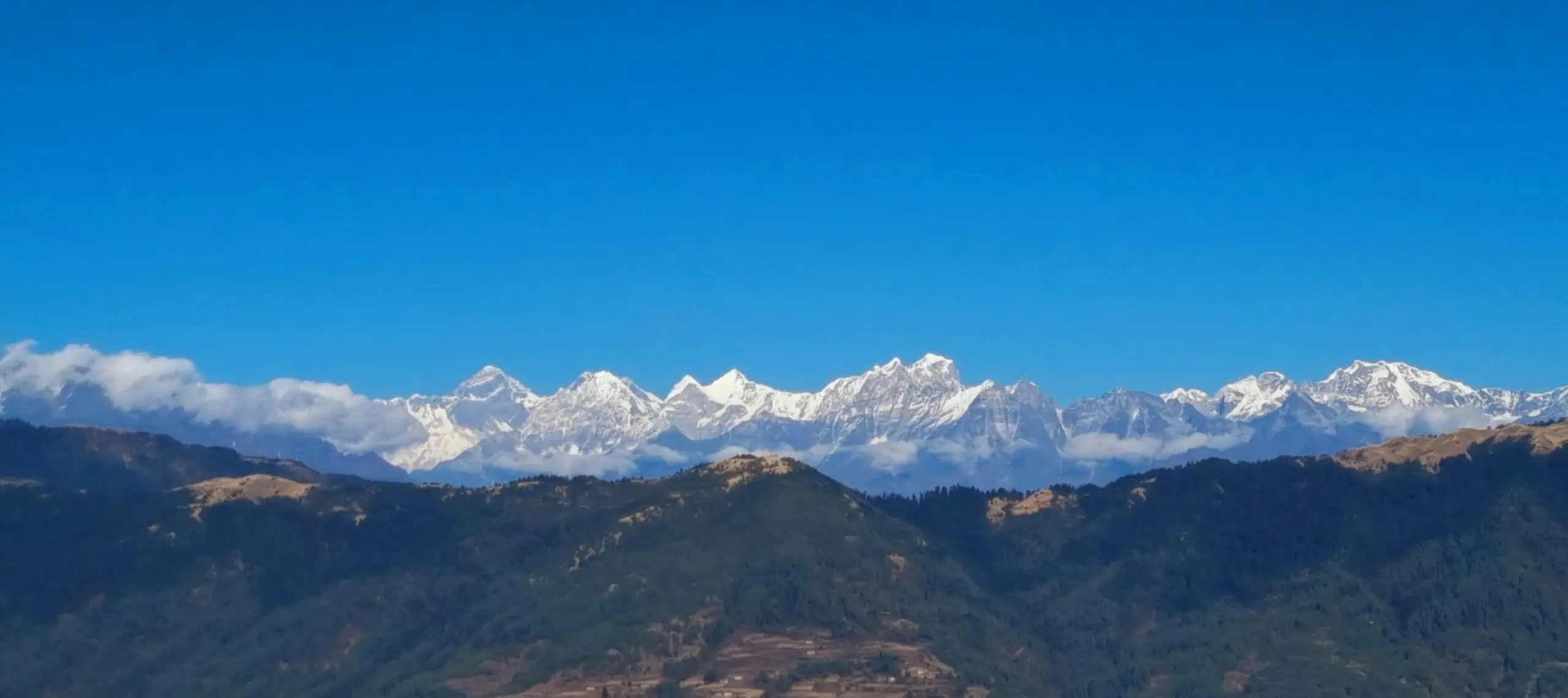
Jomsom Valley Trek 12 Days
USD 1,450
USD 1,399 per person
| Activities | - | Fitness Level | Easy |
| Max Elevation | 3810m | Commute | Kathmandu to Pokhara |
| Best Month | Autumn,Spring,winter | Group Size | Min: 2, Max: 10+ |
| Arrival on | Kathmandu | Depart From | Kathmandu |
| Meal | B L D | Duration | 12 Days |
| Stay | Hotel & Tea House | Price | USD 1,399 per person |
Jomsom Valley is a short and beautiful trek in Nepal’s one of the most beautiful semi urban region, which lies in the lap of Himalayan giants. Jomsom Valley Trek is a short yet beautiful trek in the rain-shadow of Annapurnas and Dhaulagiri, which caters tremendously wonderful highlights; culturally & naturally. The trek begins after a short Trans Himalayan Flight to Jomsom, the Windy City and the home to Thakalis. The trek then traverses through the biggest Apple Orchard of the country, Marpha, which is also the abode to unique tribe Marphalis. The gateway to Upper Mustang, Kagbeni is a cultural village we would admire after Marpha. Throughout the trek, the windswept landscapes of Jomsom and neighboring places blended so well so with colorful hills and sparkling Himalayan peaks will feast your eyes. The latter half of the trek takes us to the elevated common shrine Muktinath. Muktinath is one of the sacred shrines for Hindus, Buddhists, Jains and Bons. The temple above the clouds offers us a pleasant sensation of peacefulness. Then the trek slides down to Jomsom and finally after the fly out journey from Jomsom, the trek ends at Pokhara. In addition, if you have wish to enjoy natural beauties, enhance cultural experiences with enough time to explore the Hidden Kingdom, you can join us our Mustang Valley Trek-17 Days or Short Upper Mustang Trek-12 Days. If you are not satisfied with this itinerary or if you want to customize this package in your timeline or budget, then you could contact us, or email to [email protected]
Outline Itinerary:
Day 01: Arrival day in Kathmandu (1,300m/4,264 ft). Meal: Dinner)
Day 02: Cultural Tour in Kathmandu city & trek preparation ( 1350/4428 ft). Meal: Breakfast)
Day 03: Drive from Kathmandu to Pokhara (823m/2,700ft) Drive: 6/7 hrs. Meal: Breakfast)
Day 04: Flight from Pokhara to Jomsom (2800m/9240 ft),Trek to Marpha ( 2650m/8745 ft) Flight: 20 minutes Trek: 3/4 hrs. (Meal: BLD)
Day 05: Trek to Tukuche (2550 m/8415 ft) Trek: 3/4 hrs.( Meal: BLD)
Day 06: Trek to Kagbeni (2810 m/9273 ft. Trek: 4-5 hrs. (Meal: BLD)
Day 07: Trek to Muktinath (3800m/12540 ft) Trek: 5-6 hrs. (Meal: BLD)
Day 08: Trek to Ekali Bhatti via Lupra ( 2740 m/9040 ft. Trek: 3/4 hrs. (Meal: BLD) Day 09: Trek to Jomsom (2800m/9240 ft. Trek: 3/4 hrs. (Meal: BLD)
Day 10: Flight from Jomsom to Pokhara (823m/2700ft Flight: 20 minutes (Meal: Breakfast)
Day 11: Drive back to Kathmandu (1350/4428 ft) (Meal: B/D) Day 12 Departure from Kathmandu (1350/4428 ft) (Meal: B)
Costs
What is included
🟢Airport transfer by Hiking Nepal office representative in a private vehicle
🟢Welcome Dinner at Typical Nepalese Restaurant with cultural dance show
🟢Farewell Dinner at finest restaurant in Thamel Kathmandu
🟢3 nights’ accommodation at Tourist Standard Hotel in Kathmandu with breakfast on twin sharing basis
🟢6 nights’ accommodation at well and comfortable Mountain Lodge available en-route during trek (Few nights’ at during trek with attached bathroom/toilets)
🟢2 night’s accommodation at 3 star Hotel in Pokhara with breakfast on twin sharing basis
🟢Full board meal during trek (Breakfast, Lunch, Dinner, tea & coffee, seasonal fruits, chocolate/s & biscuits)
🟢English speaking, First Aid and Eco-trained local trekking guide, Assistance guide as per the group size, porters (2:1)
🟢All the expenses for guide and porters along with Insurance
🟢Domestic Airfare and Tax for the sector Pokhara/Jomsom/Pokhara
🟢Kathmandu/Pokhara/Kathmandu transfer in a Tourist Bus
🟢Annapurna Conservation Area Project (ACAP) fee
🟢Guided sightseeing tour in Kathmandu by English speaking local guide
🟢Exclusive medical kit bag, Duffle Bag, Trekking T-shirt, Adventure Certificate
🟢Sleeping Bag and Down Jacket during Trek
🟢All government and local taxes as applicable
What is not included
🔴Nepal Visa - (Cost- US$- 30 for 15 days & $- 50 for 30 days)
🔴Lunch & evening meals while in Kathmandu (Except welcome/farewell dinner)
🔴Travel insurance
🔴Cost of personal nature expenses, Beverages (Mineral water or coca-cola), cost of extra meals, snacks, phones bills, Internet, WiFi, laundry etc.
🔴The cost incurred during emergencies, evacuations
🔴Tips for Guide/porters/driver …
DETAILED ITINERARY
Day 01 Arrival day in Kathmandu (Altitude: 1,300m/4,264 ft. Meal: Dinner)
On your arrival in Kathmandu International Airport, one of our representative will pick up you and escort you to the hotel as well as help you to check-in at hotel. After your refreshment, you will be briefed about the next day trip. In the evening, we, the Hiking Nepal will offer you a welcome dinner introducing Nepalese cuisine and culture.
Day 02 Cultural Tour in Kathmandu city & trek preparation (Altitude: 1350/4428 ft. Meal: Breakfast)
After your delightful breakfast, you will be introduced with guide and takes you to UNESCO Heritages sites of the valley where you will observe living heritage of Medieval Nepal - Witness the biggest Hindu temple of Nepal, Pashupatinath and capture the sacred moments of Hindu death ritual at Aryaghat in Pashupatinath. Stroll the lively streets of Kathmandu Old Market Asan to Kathmandu Durbar Square and visit the home of The Living Goddess Kumari, Nepalese style of Architecture as well as astonishing wooden carving. A short drive from Kathmandu Durbar Square will take you to a hill top stupa called as “Swyambhu” meaning “self -emerge” and belief that the hill emerged impulsively from the great lake that once covered Kathmandu valley. Also known as Monkey temple.
Day 03 Drive from Kathmandu to Pokhara (Altitude: 823m/2,700ft Drive: 6/7 hrs. Meal: Breakfast)
Early morning, after breakfast, catch Tourist bus or we can also organize a private vehicle for you. Viewing countryside villages, farm, shops and river, you will reach at Pokhara. A beautiful place with tremendous views of mountains and lakes. Upon reaching at Pokhara, you will be escorted to your hotel. You can also go for Boating at Fewa Lake. Overnight at Hotel.
Day 4- Flight from Pokhara to Jomsom,Trek to Marpha (Altitude: Marpha: 2650m/8745 ft. Jomsom: 2800m/9240 ft. Flight: 20 minutes Trek: 3/4 hrs. Meal: BLD)
After having breakfast, you will be transferred to airport in a private vehicle. A short flight to Pokhara to Jomsom will thrill you. As you land at Jomsom Airport, your trek will starts. First stoppage for the trek is Marpha (2650m) which comes after a short trek of 3-4 hours. This place is famous for its apples and juices, brandy made out of apples. Jomsom is a windy place. Overnight at a local lodge in Marpha.
Day 05 Trek to Tukuche (Altitude: 2550 m/8415 ft. Trek: 3/4 hrs. Meal: BLD)
Tukuche is another destination to stop for the night which is also a short trek from Marpha. The trial to Tukuche is a bit dusty with jeeps and motorcycles hurtling by at pretty much of high speed. Beginning the trek early morning is highly recommended. Magnificent hills and Kali Gandaki gushing throughout the trial are the major attractions of today’s trek. Overnight in a local lodge at Tukuche.
Day 06- Trek to Kagbeni (Altitude: 2810 m/9273 ft. Trek: 4-5 hrs. Meal: BLD)
Today’s trek will takes you to Kagbeni is which is 4-5 hours of walk. After walking in dust and stony bank of the river in previous days, the sight of Kagbeni will definitely please your eyes. The lush vegetation is what you might have missed during other days trek. Resting for an hour or so after reaching there and talking a stroll to the small town is quite an experience. Overnight in a local lodge at Kagbeni.
Day 07 Trek to Muktinath (Altitude: 3800m/12540 ft. Trek: 5-6 hrs. Meal: BLD)
Once, you gear up, you will begins to walk along the longest and highest trail of the trek which brings you to the maximum elevation of the trek, Muktinath(3800m). The old valley and town captivates you. The temple of Muktinath is a holy destination for Hindu and Buddhist devotees. You are likely to get exhausted because it is uphill climb all along. Restaurants and small pubs are also the other attractions besides the temple at Muktinath. Spend overnight at local lodge.
Day 08 Trek to Ekali Bhatti via Lupra (Altitude: 2740 m/9040 ft. Trek: 3/4 hrs. Meal: BLD)
Today, you will walk in a downhill trail towards Lupra lies in the bank of Panda River. It is a small settlement of Thakali ethnic group with unique culture, tradition and lifestyle. Here, you can also see an ancient Bon Gompa. Resting for a while, you will starts to walk in an ups and down trail that takes you to Ekle Bhatti. Spend overnight at local lodge.
Day 09 Trek to Jomsom (Altitude: 2800m/9240 ft. Trek: 3/4 hrs. Meal: BLD)
Now, it’s a time to retrace back to Jomsom through downhill. You always have to be cautious and not be excited to reach the destination. It will be your final day of your trek, hence, you can celebrate with guide and porters as well as taste some local drinks. Spend overnight at local lodge.
Day 10 Flight from Jomsom to Pokhara (Altitude: 823m/2,700ft Flight: 20 minutes Meal: Breakfast)
From the windy city Jomsom, you will take a flight back to Pokhara. Leaving the tranquil isolation as you land at Pokhara, you will be once again transferred to your hotel in the city. Rest of the evening on your own. Spend overnight at Hotel.
Day 11 Drive back to Kathmandu (Altitude: 1350/4428 ft. Meal: B/D)
You can either fly or drive to Kathmandu based on your feasibility and comfort. During flight, you can reach Kathmandu within 30 minutes after departure from Pokhara. Whilst, driving will takes around 7 hours to reach Kathmandu, however, you can grasp the countryside life. The 1st half of the trip is along the highway above Seti and Marsyandi Rivers and the latter half winds along Trisuli River. Green hills along the spiral roads, stopping in between for snacks (fish) are the trip highlights. Upon arriving at Kathmandu, you will be transferred to the hotel in the city. Take your time for refreshment. Evening, we, Hiking Nepal team, invite you for a dinner. Give us chance to make your evening a wonderful time.
Day 12 Departure from Kathmandu (Altitude: 1350/4428 ft. Meal: B)
Completing the most wonderful 12 days long vacation in Nepal, today you will be departing back to home. As per your flight schedule you will be transferred to the airport by your tour officer in a private vehicle. As your welcoming was special, Hiking Nepal will give you a special see off.
DEPARTURE DATES
| START DATE | END DATE | STATUS | PRICES |
|---|---|---|---|
| No departures found for October | |||
FAQ
No FAQs available for this tour.
REVIEWS
No reviews yet.
RELATED TRIPS

Sunder Peak Trek
Sunder Peak, a short trekking in the Everest Region follows the traditionally and historically impor...
More Details
Pikey Peak Trek
Pikey Trek- short and outstanding trekking to the Himalayas viewing the stunning Himalayas including...
More Details
| 1 person | 2-7 person | 8+ person |
|---|---|---|
|
$ 1,399
Partial Pay
|
$
1,299
/ per
Partial Pay
|
$
1,255
/ per
Partial Pay
|




- Speak to one of our travel consultants
- Call Us (24/7) : +977 9802342080
-
 WhatsApp (24/7) : +977-9802342080
WhatsApp (24/7) : +977-9802342080
Planning a Trip?
We have a pool of travel experts working in this industry for more than a decade. Consult to get started
BOOK A CALL